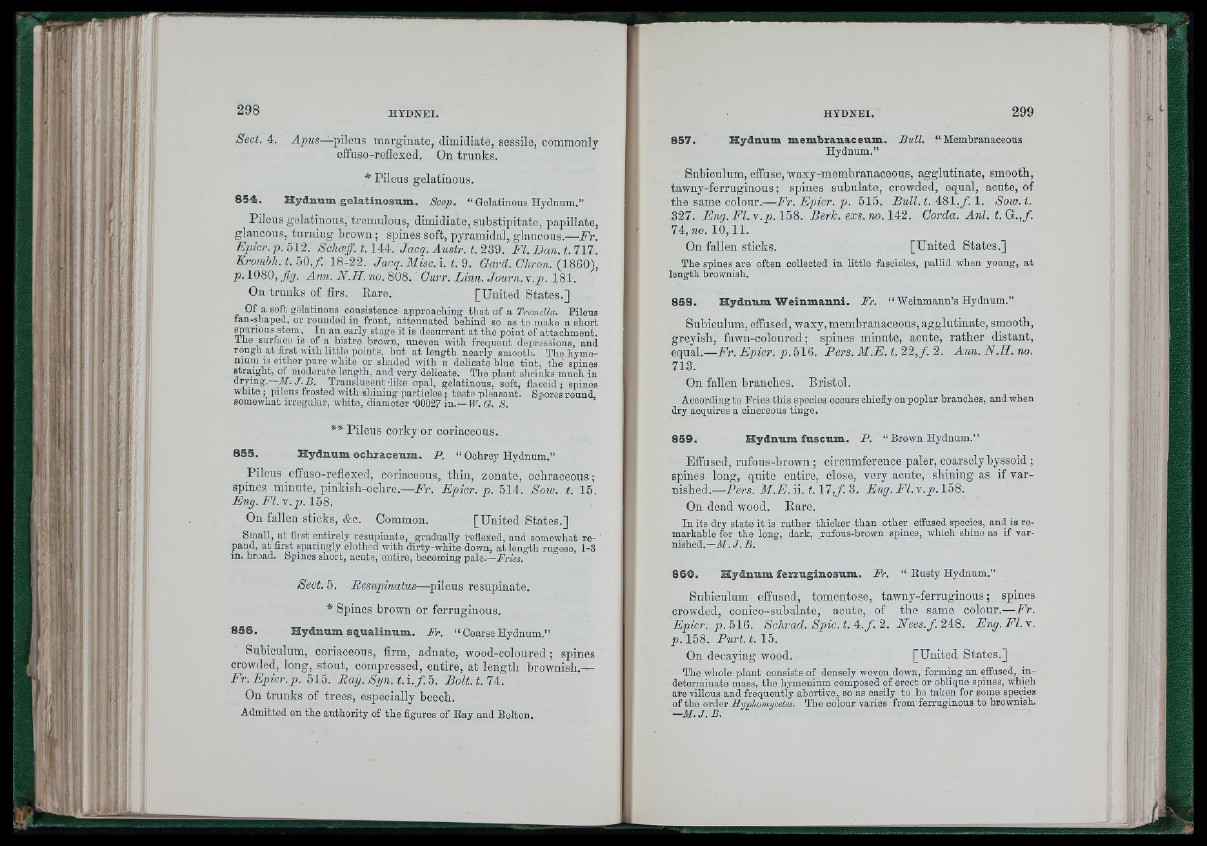
;; if.r
I
m
Sect. 4.
HYDNEI.
ripas—pileus marginate, dimidiate, sessile, commonly
effuso-reflexed. On trunks.
* Pileus gelatinous.
8 5 4 . H yd n um g e la tin o sum . Scop. “ Gelatinous Hydnum."
Pileus gelatinous, tremulous, dimidiate, substipitate, papillate,
glaucous, turning brown ; spines soft, pyramidal, glaucous.—Fr.
Epicr. p. 512. Schoeff. 1.144. Jacq. Austr. t. 239. F l. B an. t. 717.
Kromhh. t. 50, f . 18-22. Jacq. Misc.i. t.9 . Gard. Chron. (I860),
p. 1080, fig. Ann. N .H . no. 808. Curr. Linn. Journ. Y. p. 181.
On trunks of firs. Rare. [United States.]
Of a soft gelatinous consistence approaching that of a Tremdla. Pilens
fan-shaped, or rounded in front, attenuated behind so as to make a short
fu rio u s stem. In an early stage it is decnrrent at the point of attachment.
The surface is of a bistre brown, uneven with frequent depressions, and
rough at first with Uttle points, but at length nearly smooth. The hyme-
mum is either pure white or shaded with a delicate blue t. nf Tnnrlprilfo lAno-fll rra-nTT flrtlîrtol-« T'U.-.1.y..aJ. tint, the spines straight, qf_nioderate length, and very delicate. The plant ~sh1 ,r..i:n„ 1k_s__ m ucTh_ in
drying. M. J. B. TTrraa^nosiluuucuennut --iliijkaeo uoppaail,, ggceilaactiixnioouuss,, ssoorfet,, nflaaeccciida ;; ssppiinneess
white; pileus frosted with shining particles; taste pleasant. Spores round,
somewhat irregular, white, diameter '00027 in.—TP. G. S.
** Pileus corky or coriaceous.
8 5 5 . H y d n um o ch za c eum . P. " Oohrey Hydnum.”
Pilous effuso-reflexed, coriaceous, thin, zonato, ochraceous;
spines minute, pinkisb-ochre.—E?\ Epicr. p. 514. Sow. t. 15.
Eng. Fl. Y. p . 158.
On fallen sticks, &c. Common. [United States.]
Small, at first entirely resupinate, gradually refiexed, and somewhat re-
pand, at first sparingly clothed with dirty-white down, at length rugose, 1-3
in. broad. Spines short, acute, entire, becoming pale.—Fries.
Sect. 5. Besupinatus—^pileus resupinate.
* Spines brown or ferruginous.
8 5 6 . H yd n um sq u a lin um . Fr. “ Coarse Hydnum.”
Subiculum, coriaceous, firm, adnate, wood-coloured; spines
crowded, long, stout, compressed, entire, at length brownisb.—
F r .E p ic r .p . 515. Bay. Syn. t . i . f . 5. Bolt. t.74.
On trunks of trees, especially beecb.
Admitted on the authority of the figures of Eay and Bolton.
8 5 7 . H yd n um m em h zan a c eum .
Hydnum,”
B u ll. “ Membranaceous
Subiculum, effuse, waxy-membranaceous, agglutinate, smooth,
tawny-ferruginous ; spines subulate, crowded, equal, acute, of
the same colour.—Fr. Epicr. p. 515. Da«, i. 4 8 1 ,/. 1. Sow.t.
327. Eng. F I .y . p. 158. Berk. exs. no. 142. Corda. Ani. i. G . , /
74, no. 10,11.
On fallen sticks. [United States.]
The spines are often collected in little fascicles, pallid when young, at
length brownish.
8 5 8 , H yd n um W e inm a n n i, Fr. ‘‘Weinmann’s Hydnum.”
Subiculum, effused, waxy,membranaceous, agglutinate, smooth,
greyish, fawn-coloured; spines minute, acute, rather distant,
equal.—Fr. Epicr. p. 516. Pers. M .E . t. 22, f . 2. Ann. N .H . no.
713.
On fallen branches. Bristol.
According to Fries this species occurs chiefly on poplar branches, and when
dry acquires a cinereous tinge.
8 5 9 . H y d n um fu s cum . P. “ Brown Hydnum.”
Effused, rufous-brown ; circumference paler, coarsely byssoid ;
spines long, quite entire, close, very acute, shining as if varnished.—
Pers. M .E . ii. 1.11,f . 3. Eng. F I . y .p. 158.
On dead wood. Rare.
In its dry state it is rather thicker than other effased species, and is remarkable
for the long, dark, rufous-brown spines, which shine as if varnished
»—M. J. B.
8 6 0 . H yd n um fersruginosum, Fr, “ Rusty Hydnum.”
Subiculum effused, tomentose, tawny-ferruginons; spines
crowded, oonico-subulate, acute, of tbe same colour.— F r .
Epicr. p . 516. Schrad. Sp ic .t. 4. f . 2 . N e e s .f.248. Eng. F I .y .
p. 158. Purt. t. 15.
On decaying wood. [United States.]
The whole plant consists of densely woven down, forming an effused, indeterminate
mass, the hymenium composed of erect or oblique spines, which
are villous and frequently abortive, so as easily to be taken for some species
ofthe order Hyplwmyceles. The colour varies from ferruginous to brownish.
—M. J . B.